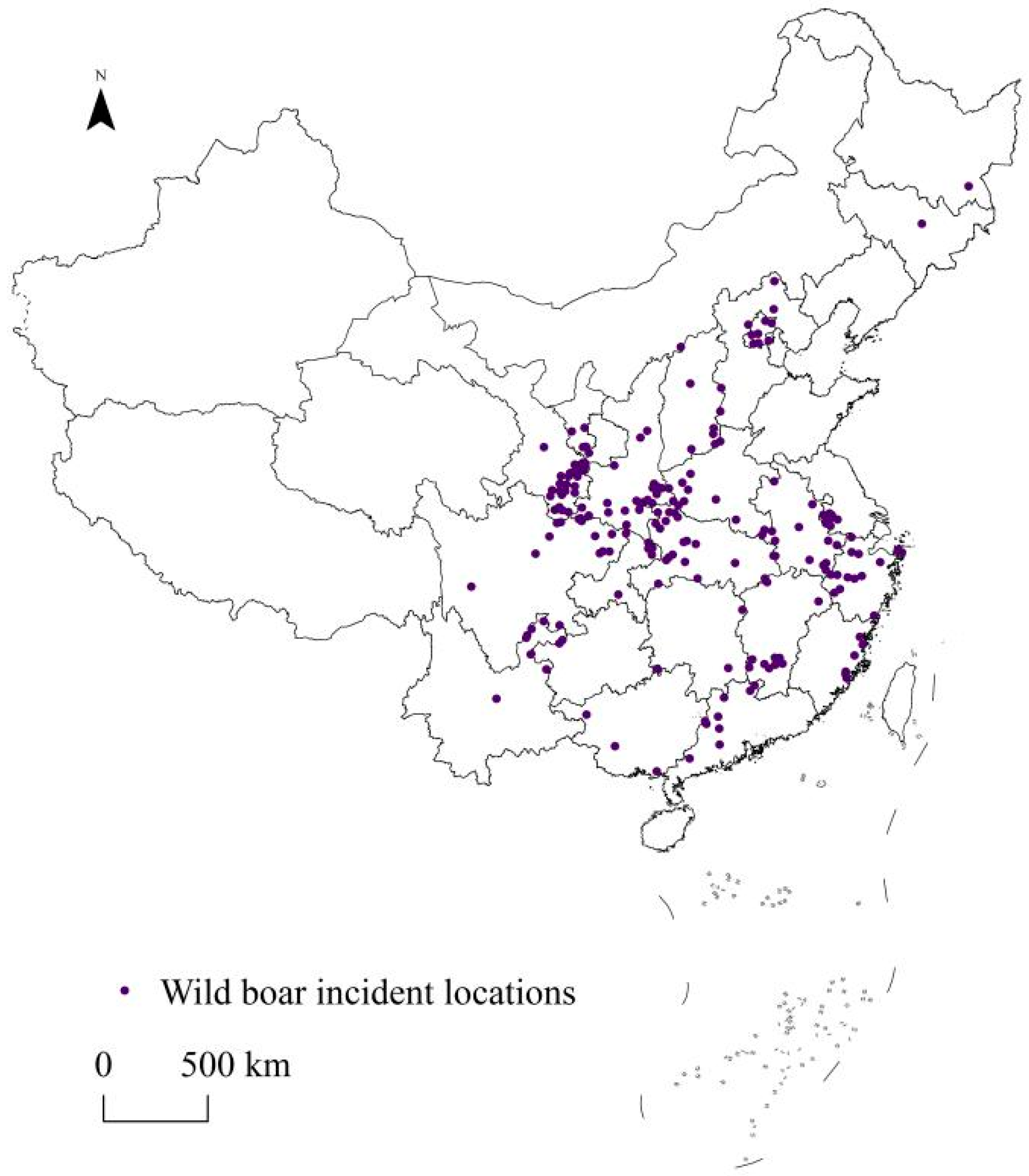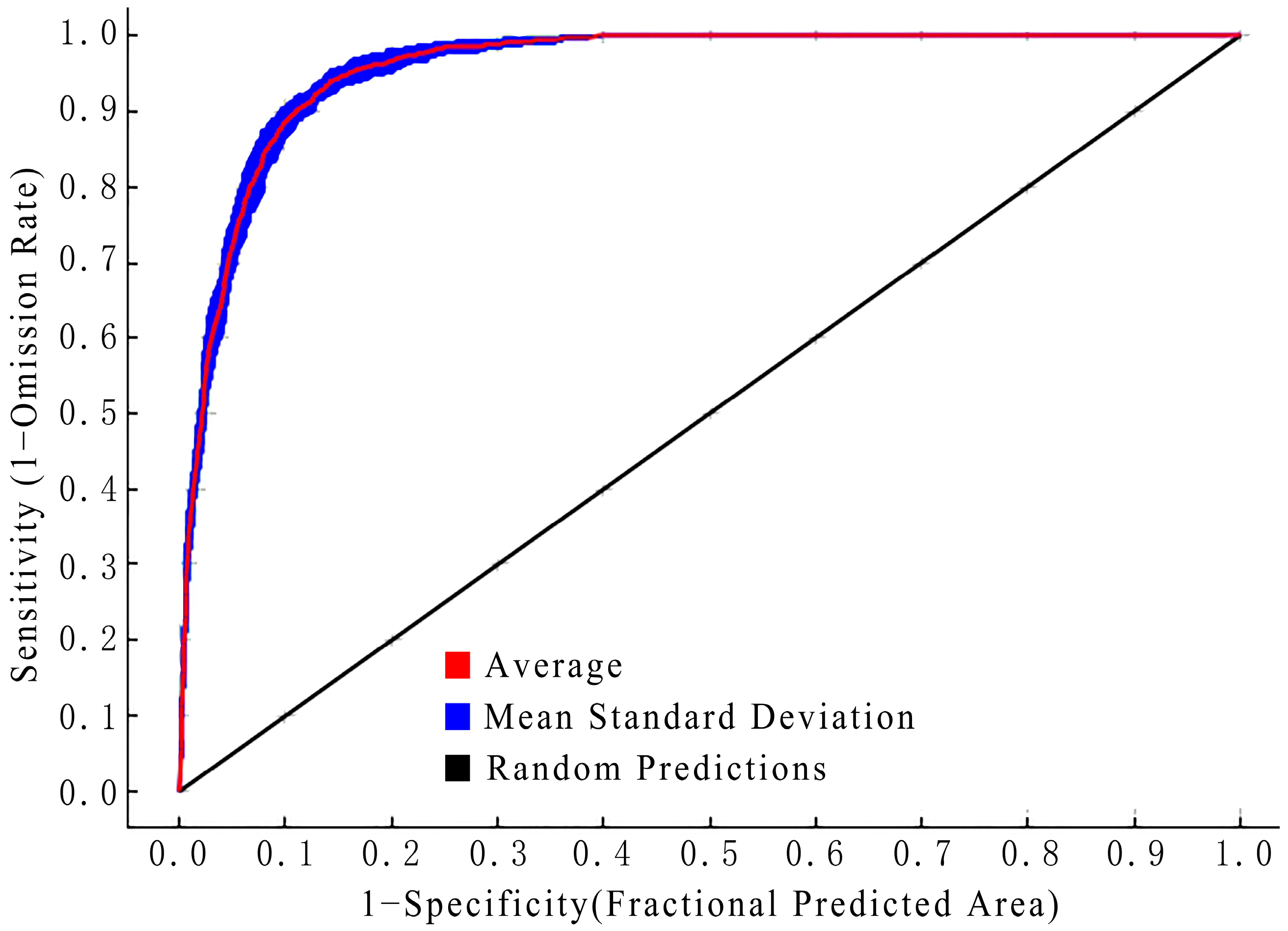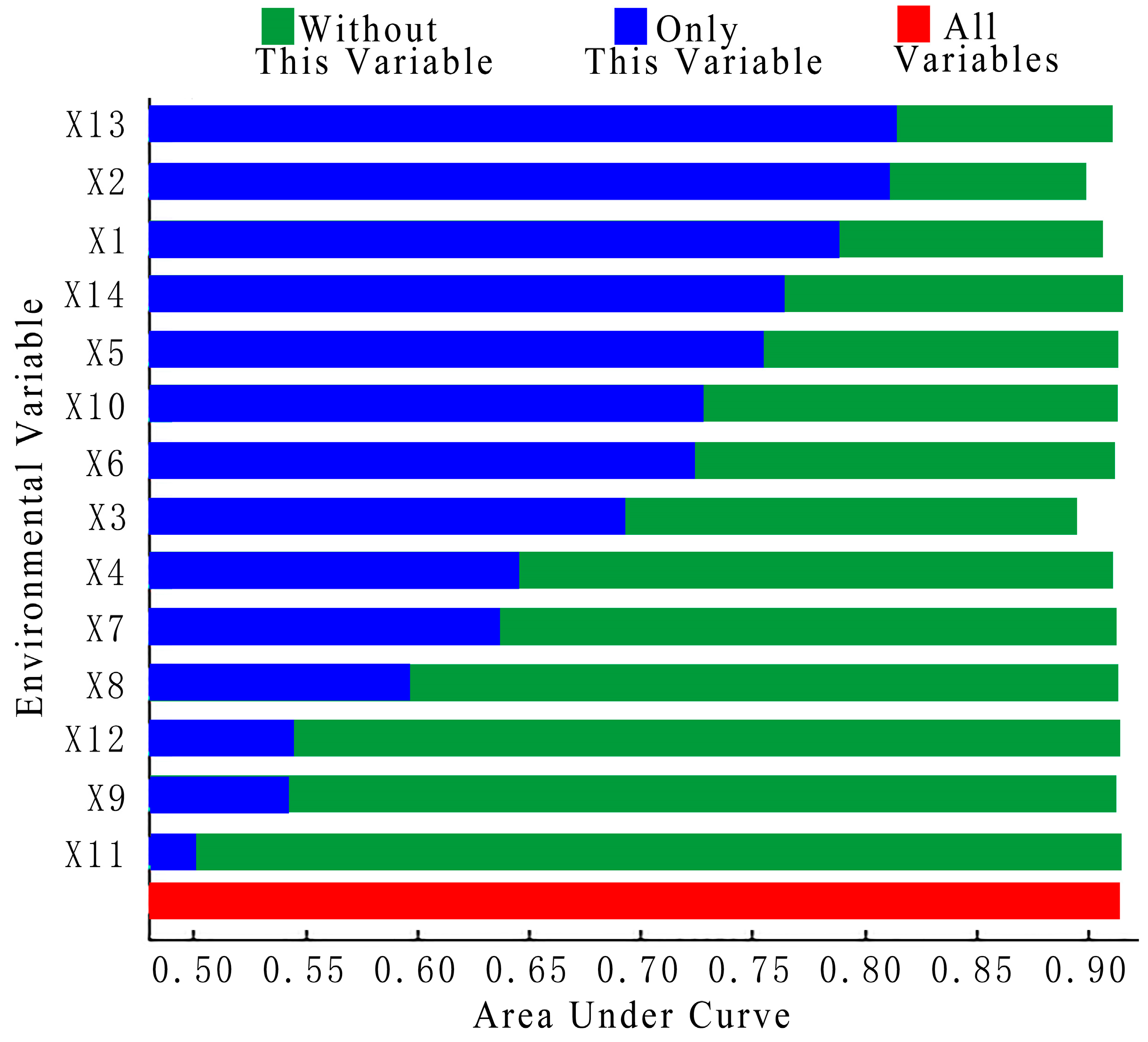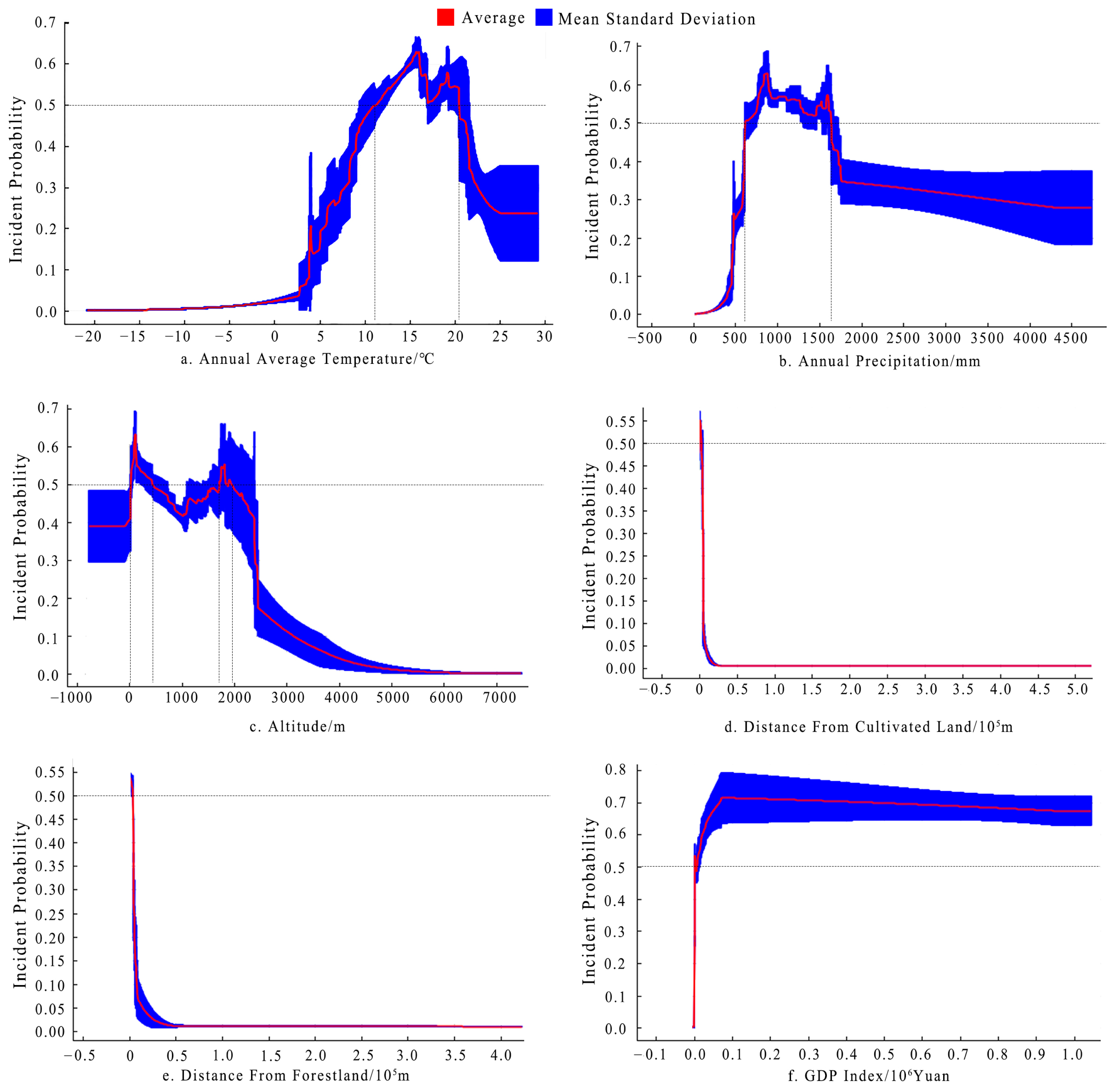Identifying the Risk Regions of Wild Boar (Sus scrofa) Incidents in China
Abstract
:Simple Summary
Abstract
1. Introduction
2. Data and Methods
2.1. Data
2.1.1. Wild Boar Incident Locations
2.1.2. Environmental Variable Data
2.2. Methods
2.2.1. Maxent Model
2.2.2. Data Analysis
3. Results
3.1. Environmental Variables
3.1.1. Contribution of Environmental Variables
3.1.2. Dynamic Response of Environmental Variables
3.2. Distribution of the Risk Space of Wild Boar Incidents
4. Discussion
4.1. Expansion of Data Sources
4.2. Environmental Variable System Construction
4.3. Management Recommendation
4.4. Suggestions for Future Research
Supplementary Materials
Author Contributions
Funding
Institutional Review Board Statement
Informed Consent Statement
Data Availability Statement
Conflicts of Interest
References
- Penteriani, V.; Delgado, M.M.; Pinchera, F.; Naves, J.; Ferna’ndez-Gil, A.; Kojola, I.; Harkonen, S.; Norberg, H.; Frank, J.; Fedriani, J.M.; et al. Human behaviour can trigger large carnivore attacks in developed countries. Sci. Rep. 2016, 6, 20552. [Google Scholar] [CrossRef] [PubMed]
- van Eeden, L.M.; Crowther, M.S.; Dickman, C.R.; Macdonald, D.W.; Ripple, W.J.; Ritchie, E.G.; Newsome, T.M. Managing conflict between large carnivores and livestock. Conserv. Biol. 2018, 32, 26–34. [Google Scholar] [CrossRef] [PubMed]
- Macdonald, S.L.; Bradford, M.; McKeown, A.; Vanderduys, E.; Hoskins, A.; Westcott, D. Camp site habitat preferences of the little red flying-fox (Pteropus scapulatus) in Queensland. Aust. J. Zool. 2021, 68, 234–253. [Google Scholar] [CrossRef]
- Frank, B. Human–wildlife conflicts and the need to include tolerance and coexistence: An introductory comment. Soc. Nat. Resour. 2016, 29, 738–743. [Google Scholar] [CrossRef]
- Ikanda, D.; Packer, C. Ritual vs. retaliatory killing of African lions in the Ngorongoro Conservation Area, Tanzania. Endanger. Species Res. 2008, 9, 67–74. [Google Scholar] [CrossRef]
- Mateo-Tomas, P.; Olea, P.P.; Sanchez-Barbudo, I.S.; Mateo, R. Alleviating human-wildlife conflicts: Identifying the causes and mapping the risk of illegal poisoning of wild fauna. J. Appl. Ecol. 2012, 49, 376–385. [Google Scholar] [CrossRef]
- Venumiere-Lefebvre, C.C.; Breck, S.W.; Crooks, K.R. A systematic map of human-carnivore coexistence. Biol. Conserv. 2022, 268, 109515. [Google Scholar] [CrossRef]
- Dai, Y.C.; Hacker, C.E.; Zhang, Y.G.; Li, Y.; Li, J.; Xue, Y.D.; Li, D.Q. Identifying the risk regions of house break-ins caused by Tibetan brown bears (Ursus arctos pruinosus) in the Sanjiangyuan region, China. Ecol. Evol. 2020, 9, 13979–13990. [Google Scholar] [CrossRef]
- Amit, R.; Jacobson, S.K. Stakeholder barriers and benefits associated with improving livestock husbandry to prevent jaguar and Puma depredation. Hum. Dimens. Wildl. 2017, 22, 246–266. [Google Scholar] [CrossRef]
- Ango, T.G.; Borjeson, L.; Senbeta, F. Crop raiding by wild mammals in Ethiopia:impacts on the livelihoods of smallholders in an agriculture-forest mosaic landscape. Oryx 2017, 51, 527–537. [Google Scholar] [CrossRef]
- Drouilly, M.; Kelly, C.; Cristescu, B.; Teichman, K.J.; O’Riain, M.J. Investigating the hidden costs of livestock guarding dogs: A case study in Namaqualand, South Africa. J. Vertebr. Biol. 2020, 69, 20033. [Google Scholar] [CrossRef]
- Yang, H.B.; Lupi, F.; Zhang, J.D.; Liu, J.G. Hidden cost of conservation: A demonstration using losses from human-wildlife conflicts under a payments for ecosystem services program. Ecol. Econ. 2020, 169, 106462. [Google Scholar] [CrossRef]
- Fraser-Celin, V.L.; Hovorka, A.J.; Silver, J.J. Human conflict over wildlife: Exploring social constructions of African wild dogs (Lycaon pictus) in Botswana. Hum. Dimens. Wildl. 2018, 23, 341–358. [Google Scholar] [CrossRef]
- Pozo, R.A.; LeFlore, E.G.; Duthie, A.B.; Bunnefeld, N.; Jones, I.L.; Minderman, J.; Rakotonarivo, O.S.; Cusack, J.J. A multispecies assessment of wildlife impacts on local community livelihoods. Conserv. Biol. 2021, 35, 297–306. [Google Scholar] [CrossRef]
- Bautista, C.; Revilla, E.; Berezowska-Cnota, T.; Fernandez, N.; Naves, J.; Selva, N. Spatial ecology of conflicts: Unravelling patterns of wildlife damage at multiple scales. Proc. R. Soc. B—Biol. Sci. 2021, 288, 20211394. [Google Scholar] [CrossRef]
- van Eeden, L.M.; Slagle, K.; Crowther, M.S.; Dickman, C.R.; Newsome, T.M. Linking social identity, risk perception, and behavioral psychology to understand predator management by livestock producers. Restor. Ecol. 2020, 28, 902–910. [Google Scholar] [CrossRef]
- Wilkinson, C.E.; McInturff, A.; Miller, J.R.B.; Yovovich, V.; Gaynor, K.M.; Calhoun, K.; Karandikar, H.; Martin, J.V.; Parker-Shames, P.; Shawler, A.; et al. An ecological framework for contextualizing carnivore-livestock conflict. Conserv. Biol. 2020, 34, 854–867. [Google Scholar] [CrossRef]
- Tripathy, B.R.; Liu, X.H.; Songer, M.; Kumar, L.; Kaliraj, S.; Das Chatterjee, N.; Wickramasinghe, W.M.S.; Mahanta, K.K. Descriptive spatial analysis of human-elephant conflict (HEC) distribution and mapping HEC hotspots in Keonjhar forest division, India. Front. Ecol. Evol. 2021, 9, 640624. [Google Scholar] [CrossRef]
- Lamichhane, B.R.; Persoon, G.A.; Leirs, H.; Poudel, S.; Subedi, N.; Pokheral, C.P.; Bhattarai, S.; Gotame, P.; Mishra, R.; de Iongh, H.H. Contribution of buffer zone programs to reduce human-wildlife impacts: The case of the Chitwan National Park, Nepal. Hum. Ecol. 2019, 47, 95–110. [Google Scholar] [CrossRef]
- Yin, D.; Yuan, Z.J.; Li, J.; Zhu, H. Mitigate human-wildlife conflict in China. Science 2021, 373, 500–501. [Google Scholar] [CrossRef]
- Matseketsa, G.; Muboko, N.; Gandiwa, E.; Kombora, D.M.; Chibememe, G. An assessment of human-wildlife conflicts in local communities bordering the western part of Save Valley Conservancy, Zimbabwe. Glob. Ecol. Conserv. 2019, 20, e00737. [Google Scholar] [CrossRef]
- Ravenelle, J.; Nyhus, P.J. Global patterns and trends in human-wildlife conflict compensation. Conserv. Biol. 2017, 31, 1247–1256. [Google Scholar] [CrossRef] [PubMed]
- Huang, C.; Li, X.Y.; Shi, L.J.; Jiang, X.L. Patterns of human-wildlife conflict and compensation practices around Daxueshan Nature Reserve, China. Zool. Res. 2018, 39, 406–412. [Google Scholar] [PubMed]
- Kuiper, T.; Loveridge, A.J.; Macdonald, D.W. Robust mapping of human-wildlife conflict: Controlling for livestock distribution in carnivore depredation models. Anim. Conserv. 2022, 25, 195–207. [Google Scholar] [CrossRef]
- Milda, D.; Ramesh, T.; Kalle, R.; Gayathri, V.; Thanikodi, M.; Ashish, K. Factors driving human-wild pig interactions: Implications for wildlife conflict management in southern parts of India. Biol. Invasions 2023, 25, 221–235. [Google Scholar] [CrossRef]
- Baruch-Mordo, S.; Breck, S.W.; Wilson, K.R.; Theobald, D.M. Spatiotemporal distribution of black bear-human conflicts in Colorado, USA. J. Wildl. Manag. 2008, 72, 1853–1862. [Google Scholar] [CrossRef]
- Basak, S.M.; Wierzbowska, I.A.; Gajda, A.; Czarnoleski, M.; Lesiak, M.; Widera, E. Human-wildlife conflicts in Krakow city, southern Poland. Animals 2020, 10, 1014. [Google Scholar] [CrossRef]
- Wang, C.C.; Zeng, B.X.; Song, X.Q.; Luo, D.S.; Lin, T.T. Impacts of wild boars on local livelihoods in rural communities: A case study of mountainous areas in southeast China. Front. Environ. Sci. 2023, 11, 1048808. [Google Scholar] [CrossRef]
- Brown, J.L. SDMtoolbox: A python-based GIS toolkit for landscape genetic, biogeographic and species distribution model analyses. Methods Ecol. Evol. 2014, 5, 694–700. [Google Scholar] [CrossRef]
- Yang, X.Q.; Kushwaha, S.P.S.; Saran, S.; Xu, J.C.; Roy, P.S. Maxent modeling for predicting the potential distribution of medicinal plant, Justicia adhatoda L. in Lesser Himalayan foothills. Ecol. Eng. 2013, 51, 83–87. [Google Scholar] [CrossRef]
- Baldwin, R.A. Use of maximum entropy modeling in wildlife research. Entropy 2009, 11, 856–866. [Google Scholar] [CrossRef]
- Jimenez-Valverde, A.; Lobo, J.M.; Hortal, J. Not as good as they seem: The importance of concepts in species distribution modelling. Divers. Distrib. 2008, 14, 885–890. [Google Scholar] [CrossRef]
- Lehmann, A.; Overton, J.M.; Leathwick, J.R. GRASP: Generalized regression analysis and spatial prediction. Ecol. Model. 2002, 157, 189–207. [Google Scholar] [CrossRef]
- Yee, T.W.; Mitchell, N.D. Generalized additive models in plant ecology. J. Veg. Sci. 1991, 2, 587–602. [Google Scholar] [CrossRef]
- Rubin, E.S.; Stermer, C.J.; Boyce, W.M.; Torres, S.G. Assessment of predictive habitat models for Bighorn sheep in California’s peninsular ranges. J. Wildl. Manag. 2009, 73, 859–869. [Google Scholar] [CrossRef]
- Ahmed, S.E.; McInerny, G.; O’Hara, K.; Harper, R.; Salido, L.; Emmott, S.; Joppa, L.N. Scientists and software—Surveying the species distribution modelling community. Divers. Distrib. 2015, 21, 258–267. [Google Scholar] [CrossRef]
- Phillips, S.J.; Dudík, M.; Schapire, R.E.A. Maximum Entropy Approach to Species Distribution Modeling; ACM Press: New York, NY, USA, 2004. [Google Scholar]
- Perkins-Taylor, I.E.; Frey, J.K. Predicting the distribution of a rare chipmunk (Neotamias quadrivittatus oscuraensis): Comparing MaxEnt and occupancy models. J. Mammal. 2020, 101, 1035–1048. [Google Scholar] [CrossRef]
- West, A.M.; Kumar, S.; Brown, C.S.; Stohlgren, T.J.; Bromberg, J. Field validation of an invasive species Maxent model. Ecol. Inform. 2016, 36, 126–134. [Google Scholar] [CrossRef]
- Khanum, R.; Mumtaz, A.S.; Kumar, S. Predicting impacts of climate change on medicinal asclepiads of Pakistan using Maxent modeling. Acta Oecologica 2013, 49, 23–31. [Google Scholar] [CrossRef]
- Evangelista, P.H.; Kumar, S.; Stohlgren, T.J.; Young, N.E. Assessing forest vulnerability and the potential distribution of pine beetles under current and future climate scenarios in the Interior West of the US. Forest. Ecol. Manag. 2011, 262, 307–316. [Google Scholar] [CrossRef]
- Renard, Q.; Pelissier, R.; Ramesh, B.R.; Kodandapani, N. Environmental susceptibility model for predicting forest fire occurrence in the Western Ghats of India. Int. J. Wildland Fire 2012, 21, 368–379. [Google Scholar] [CrossRef]
- Hu, H.W.; Wei, Y.Q.; Wang, W.Y.; Suonan, J.; Wang, S.X.; Chen, Z.; Guan, J.H.; Deng, Y.F. Richness and distribution of endangered orchid species under different climate scenarios on the Qinghai-Tibetan Plateau. Front. Plant Sci. 2022, 13, 948189. [Google Scholar] [CrossRef] [PubMed]
- Phillips, S.J.; Dudik, M. Modeling of species distributions with Maxent: New extensions and a comprehensive evaluation. Ecography 2008, 31, 161–175. [Google Scholar] [CrossRef]
- Hanley, J.A.; Mcneil, B.J. The meaning and use of the area under a receiver operating characteristic (ROC) curve. Radiology 1982, 143, 29–36. [Google Scholar] [CrossRef]
- Phillips, S.J.; Anderson, R.P.; Dudik, M.; Schapire, R.E.; Blair, M.E. Opening the black box: An open-source release of Maxent. Ecography 2017, 40, 887–893. [Google Scholar] [CrossRef]
- Chen, M.X.; Gong, Y.H.; Li, Y.; Lu, D.D.; Zhang, H. Population distribution and urbanization on both sides of the Hu Huanyong Line: Answering the Premier’s question. J. Geogr. Sci. 2016, 26, 1593–1610. [Google Scholar] [CrossRef]
- Na, X.D.; Zhou, H.T.; Zang, S.Y.; Wu, C.S.; Li, W.L.; Li, M. Maximum Entropy modeling for habitat suitability assessment of Red-crowned crane. Ecol. Indic. 2018, 91, 439–446. [Google Scholar] [CrossRef]
- Zhang, J.P.; Zhang, Y.L.; Liu, L.S.; Nie, Y. Predicting potential distribution of Tibetan Spruce (Picea smithiana) in Qomolangma (Mount Everest) national nature preserve using maximum entropy niche-based model. Chin. Geogr. Sci. 2011, 21, 417–426. [Google Scholar] [CrossRef]
- Luo, X.; Liang, L.; Liu, Z.X.; Wang, J.H.; Huang, T.; Geng, D.; Chen, B.Q. Habitat suitability evaluation of the Chinese Horseshoe Bat (R. sinicus) in the Wuling mountain area based on MAXENT modelling. Pol. J. Environ. Stud. 2020, 29, 1263–1273. [Google Scholar] [CrossRef]
- Abidin, K.Z.; Lihan, T.; Taher, T.M.; Nazri, N.; Zaini, I.H.A.; Mansor, M.S.; Topani, R.; Nor, S.M. Predicting potential conflict areas of the Malayan sun bear (Helarctos malayanus) in Peninsular Malaysia using Maximum Entropy model. Mammal Study 2019, 44, 193–204. [Google Scholar] [CrossRef]
- Xu, Z.R.; Wei, Z.Q.; Jin, M.M. Causes of domestic livestock ? wild herbivore conflicts in the alpine of the Plateau. Environ. Dev. 2020, 34, 100495. [Google Scholar] [CrossRef]
- Honda, T.; Kawauchi, N. Methods for Constructing a Wild Boar Relative-Density Map to Resolve Human-Wild Boar Conflicts. Mammal Study 2011, 36, 79–85. [Google Scholar] [CrossRef]
- Giefer, M.; An, L. Synthesizing Remote Sensing and Biophysical Measures to Evaluate Human–wildlife Conflicts: The Case of Wild Boar Crop Raiding in Rural China. Remote Sens. 2020, 12, 618. [Google Scholar] [CrossRef]
- Jiang, X.P.; Xu, J.L.; Li, J.Q.; Xu, Y.S.; Li, Z. Spatial distribution of human-wild boar conflicts in Jiangxi Province based on MaxEnt niche model. J. For. Environ. 2018, 38, 334–340. (In Chinese) [Google Scholar]
- Abrahms, B.; Carter, N.H.; Clark-Wolf, T.J.; Gaynor, K.M.; Johansson, E.; McInturff, A.; Nisi, A.C.; Rafiq, K.; West, L. Climate change as a global amplifier of human—Wildlife conflict. Nat. Clim. Chang. 2023, 13, 224–234. [Google Scholar] [CrossRef]
- Markov, N.; Pankova, N.; Morelle, K. Where winter rules: Modeling wild boar distribution in its north-eastern range. Sci. Total Environ. 2019, 687, 1055–1064. [Google Scholar] [CrossRef]
- Morelle, K.; Lejeune, P. Seasonal variations of wild boar Sus scrofa distribution in agricultural landscapes: A species distribution modelling approach. Eur. J. Wildl. Res. 2015, 61, 45–56. [Google Scholar] [CrossRef]
- Jin, Y.C.; Kong, W.Y.; Yan, H.; Bao, G.D.; Liu, T.; Ma, Q.F.; Li, X.H.; Zou, H.F.; Zhang, M.H. Multi-Scale Spatial Prediction of Wild Boar Damage Risk in Hunchun: A Key Tiger Range in China. Animals 2021, 11, 1012. [Google Scholar] [CrossRef]
- Davidson, A.; Malkinson, D.; Shanas, U. Wild boar foraging and risk perception—Variation among urban, natural, and agricultural areas. J. Mammal. 2022, 103, 945–955. [Google Scholar] [CrossRef]
- Schell, C.J.; Stanton, L.A.; Young, J.K.; Angeloni, L.M.; Lambert, J.E.; Breck, S.W.; Murray, M.H. The evolutionary consequences of human–wildlife conflict in cities. Evol. Appl. 2021, 14, 178–197. [Google Scholar] [CrossRef]
- Miller, J.R.B.; Schmitz, O.J. Landscape of fear and human-predator coexistence: Applying spatial predator-prey interaction theory to understand and reduce carnivore-livestock conflict. Biol. Conserv. 2019, 236, 464–473. [Google Scholar] [CrossRef]
- Broekhuis, F.; Cushman, S.A.; Elliot, N.B. Identification of human–carnivore conflict hotspots to prioritize mitigation efforts. Ecol. Evol. 2017, 7, 10630–10639. [Google Scholar] [CrossRef] [PubMed]
- Rao, V.V.; Naresh, B.; Reddy, V.R.; Sudhakar, C.; Venkateswarlu, P.; Rao, D.R. Traditional management methods used to minimize wild boar (Sus scrofa) damage in different agricultural crops at Telangana state, India. Int. J. Multidiscip. Res. Dev. 2015, 2, 32–36. [Google Scholar]
- Chauhan, N.P.S.; Barwal, K.S.; Kumar, D. Human-wild pig conflict in selected states in India and mitigation strategies. Acta Silv. Lignaria Hung. 2009, 5, 189–197. [Google Scholar]
- Singh, R.; Kumar, M. Preliminary observations on the Indian wild boar (Sus scrofa) and its damage in agricultural crop fields. J. Entomol. Zool. Stud. 2018, 6, 743–747. [Google Scholar]
- Linkie, M.; Dinata, Y.; Nofrianto, A.; Leader-Williams, N. Patterns and perceptions of wildlife crop raiding in and around Kerinci Seblat National Park, Sumatra. Anim. Conserv. 2007, 10, 127–135. [Google Scholar] [CrossRef]





| Type | Variable | Number |
|---|---|---|
| Climate | Annual average temperature | X1 |
| Annual precipitation | X2 | |
| Topography | Altitude | X3 |
| Slope | X4 | |
| Landscape | Distance from cultivated land | X5 |
| Distance from forestland | X6 | |
| Distance from water source | X7 | |
| Distance from grassland | X8 | |
| Vegetation type | X9 | |
| NDVI | X10 | |
| Human disturbance | Distance from county boundary | X11 |
| Distance from road | X12 | |
| GDP index | X13 | |
| Population density | X14 |
| X1 | X2 | X3 | X4 | X5 | X6 | X7 | X8 | X9 | X10 | X11 | X12 | X13 | X14 | |
|---|---|---|---|---|---|---|---|---|---|---|---|---|---|---|
| X1 | 1.00 | 0.64 | −0.71 | −0.14 | −0.49 | −0.44 | 0.01 | 0.26 | −0.03 | 0.35 | 0.02 | −0.14 | 0.13 | 0.17 |
| X2 | 1.00 | −0.38 | 0.17 | −0.38 | −0.37 | −0.28 | −0.01 | −0.10 | 0.68 | 0.03 | −0.25 | 0.12 | 0.14 | |
| X3 | 1.00 | 0.38 | 0.61 | 0.55 | −0.06 | −0.28 | 0.00 | −0.43 | −0.01 | 0.17 | −0.10 | −0.13 | ||
| X4 | 1.00 | −0.04 | −0.04 | −0.09 | −0.20 | −0.14 | 0.13 | 0.00 | −0.09 | −0.05 | −0.07 | |||
| X5 | 1.00 | 0.71 | 0.12 | −0.02 | 0.05 | −0.51 | −0.01 | 0.36 | −0.06 | −0.08 | ||||
| X6 | 1.00 | 0.09 | 0.03 | 0.07 | −0.50 | 0.00 | 0.29 | −0.05 | −0.06 | |||||
| X7 | 1.00 | 0.28 | 0.06 | −0.32 | 0.00 | 0.27 | −0.06 | −0.08 | ||||||
| X8 | 1.00 | 0.02 | −0.08 | 0.01 | 0.18 | 0.05 | 0.08 | |||||||
| X9 | 1.00 | −0.12 | 0.00 | 0.04 | −0.01 | 0.01 | ||||||||
| X10 | 1.00 | 0.00 | −0.36 | 0.03 | 0.05 | |||||||||
| X11 | 1.00 | 0.00 | 0.02 | 0.01 | ||||||||||
| X12 | 1.00 | −0.03 | −0.05 | |||||||||||
| X13 | 1.00 | 0.44 | ||||||||||||
| X14 | 1.00 |
| Variable | Variable Contribution (Rank) | Type |
|---|---|---|
| Annual precipitation (X2) | 26.60% (1) | Climate |
| GDP index (X13) | 23.70% (2) | Human interference |
| Annual average temperature (X1) | 13.90% (3) | Climate |
| Distance from forestland (X6) | 7.70% (4) | Landscape |
| Distance from cultivated land (X5) | 7.00% (5) | Landscape |
| Altitude (X3) | 5.50% (6) | Topography |
| Slope (X4) | 4.30% (7) | Topography |
| Vegetation type (X9) | 4.30% (7) | Landscape |
| Distance from water source (X7) | 2.40% (8) | Landscape |
| Distance from grassland (X8) | 1.90% (9) | Landscape |
| Population density (X14) | 1.50% (10) | Human interference |
| NDVI (X10) | 1.10% (11) | Landscape |
| Distance from county boundary (X11) | 0.00% (12) | Human interference |
| Distance from road (X12) | 0.00% (12) | Human interference |
Disclaimer/Publisher’s Note: The statements, opinions and data contained in all publications are solely those of the individual author(s) and contributor(s) and not of MDPI and/or the editor(s). MDPI and/or the editor(s) disclaim responsibility for any injury to people or property resulting from any ideas, methods, instructions or products referred to in the content. |
© 2023 by the authors. Licensee MDPI, Basel, Switzerland. This article is an open access article distributed under the terms and conditions of the Creative Commons Attribution (CC BY) license (https://creativecommons.org/licenses/by/4.0/).
Share and Cite
Zheng, B.; Lin, X.; Qi, X. Identifying the Risk Regions of Wild Boar (Sus scrofa) Incidents in China. Animals 2023, 13, 3186. https://doi.org/10.3390/ani13203186
Zheng B, Lin X, Qi X. Identifying the Risk Regions of Wild Boar (Sus scrofa) Incidents in China. Animals. 2023; 13(20):3186. https://doi.org/10.3390/ani13203186
Chicago/Turabian StyleZheng, Boming, Xijie Lin, and Xinhua Qi. 2023. "Identifying the Risk Regions of Wild Boar (Sus scrofa) Incidents in China" Animals 13, no. 20: 3186. https://doi.org/10.3390/ani13203186
APA StyleZheng, B., Lin, X., & Qi, X. (2023). Identifying the Risk Regions of Wild Boar (Sus scrofa) Incidents in China. Animals, 13(20), 3186. https://doi.org/10.3390/ani13203186






